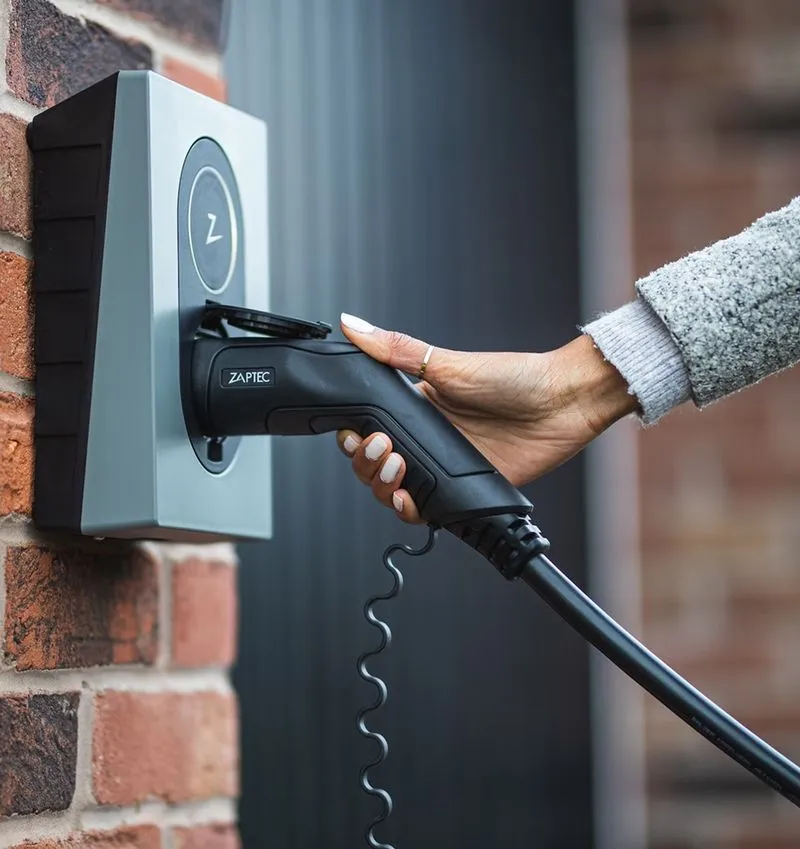How to build killer LinkedIn Ads for B2B
We’ve all heard the noise online about LinkedIn being either the ultimate place to run ads, or a place where ads are a money pit generating no conversions. Below is 42/Agency’s perspective & playbook on LinkedIn Ads they use for their customers to drive 7 figures in pipeline.
Author
Date
June 1, 2025
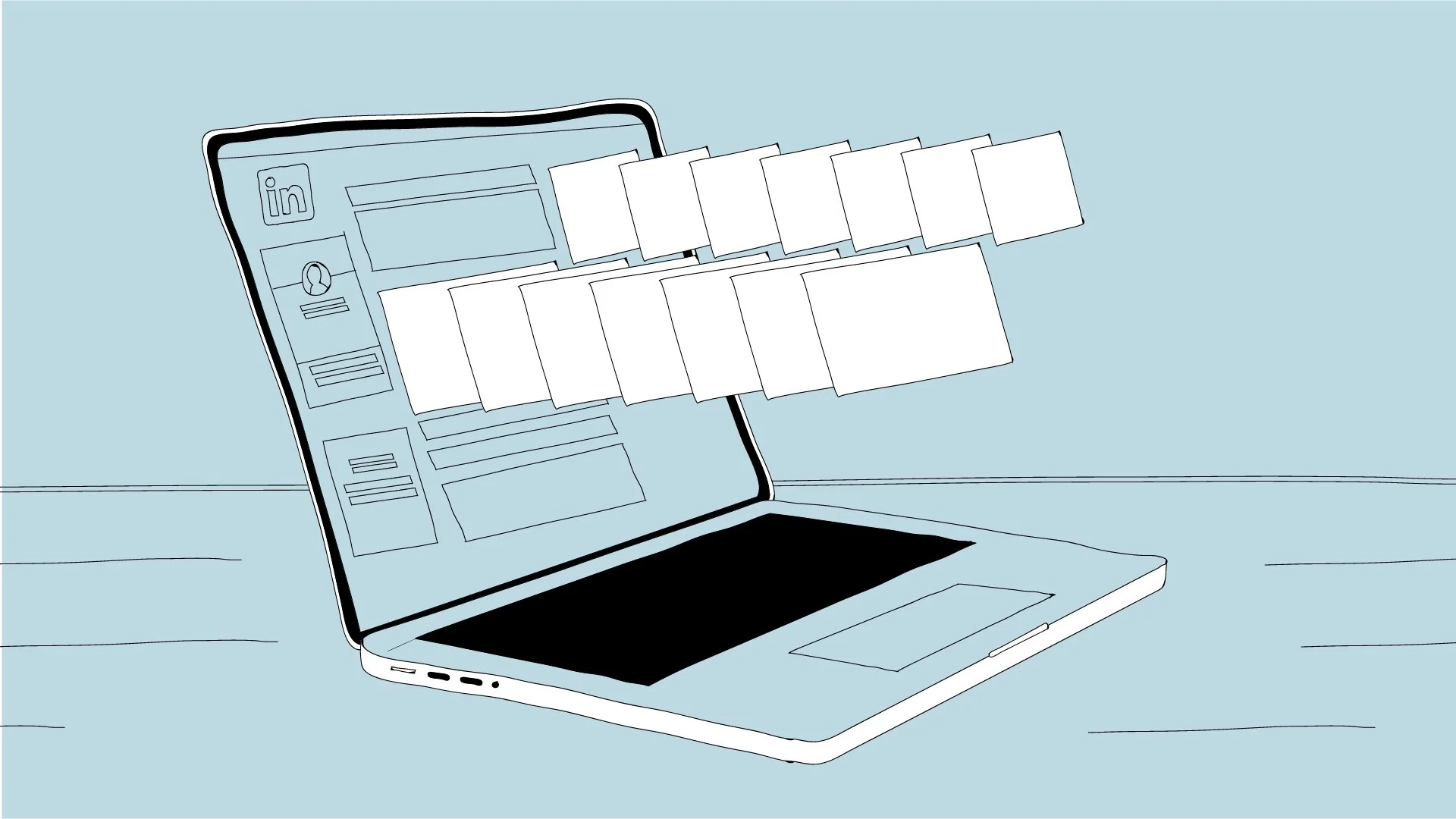
Pre-LinkedIn ads campaign checklist
The first step to creating a successful LinkedIn campaign is to check if the brand you are managing already has an audience on LinkedIn. To do so, simply to go the campaign manager, add relevant targeting (job title, country, industry, org size etc) and see what the available audiences are. Ideally, the audience size is a few 100,000 people. Unless you're targeting very specific accounts as part of your ABM strategy.
Once you have figured that out, be sure to follow this checklist to make sure you should use this network for your LinkedIn Ads:
It makes sense to use LinkedIn ads if:
✅ You want to generate a bottom-funnel strategy to generate quality conversions
✅ You have a longer sales cycle (approx. 6months - several stakeholders, etc.)
✅ You customers LTV are high ($10,000+/year or $2000+/month)
✅ You sell mid-market enterprise solutions
✅ You want to run targeted ABM plays
✅ You are selling to a niche audience. (Ex. VP of Finance and a 20 person firm)
✅ You direct qualified traffic to your website, and then remarket to them
Don't use LinkedIn ads if:
❌ You want to provide free trials (it's too expensive)
❌ You do not have a significant budget - must spend a few thousand to get anything out of it.
❌ Your LTV is low or if your product/service has a low cost.
❌ You are selling to a broad audience
Types of LinkedIn Campaigns
Now that you have looked at the checklist and decided LinkedIn meets your ad objectives, it is important to know the type of campaigns available.
- TOFU - Top of the funnel campaigns are great if you want to build your brand awareness and retargeting audiences. They might not be the ones that convert right away, but they help you get in front of more people with a limited budget. Video views and website visits campaigns work great for TOFU.
- MOFU - Middle of the funnel campaigns offer more information about your solution than TOFU ads and are meant to be created for those potential customers that are evaluating solutions such as the one you offer. The most common objectives in this type of campaign are content downloads and mid-funnel video views that explain to potential users how your B2B solution can help them solve a problem. This is where you can leverage more product marketing artifacts. How does your product - fit into the broader market + solve the customers problems?
- BOFU - Bottom of the funnel campaigns are directed towards people who already understand what your product does and the problem it solves for them. In this case, the objective is more direct response and focused on conversions. The most common formats in this type of campaign are lead gen campaigns, landing pages, and conversational ads.
Though we categorize campaigns into TOFU, MOFU, BOFU - we do not suggest to sequence campaigns in that order. Rather interlink these campaigns if you are planning to retarget. This is because buyers journey as TOFU -> MOFU -> BOFU is more theoretical and it happens dynamically in real life.
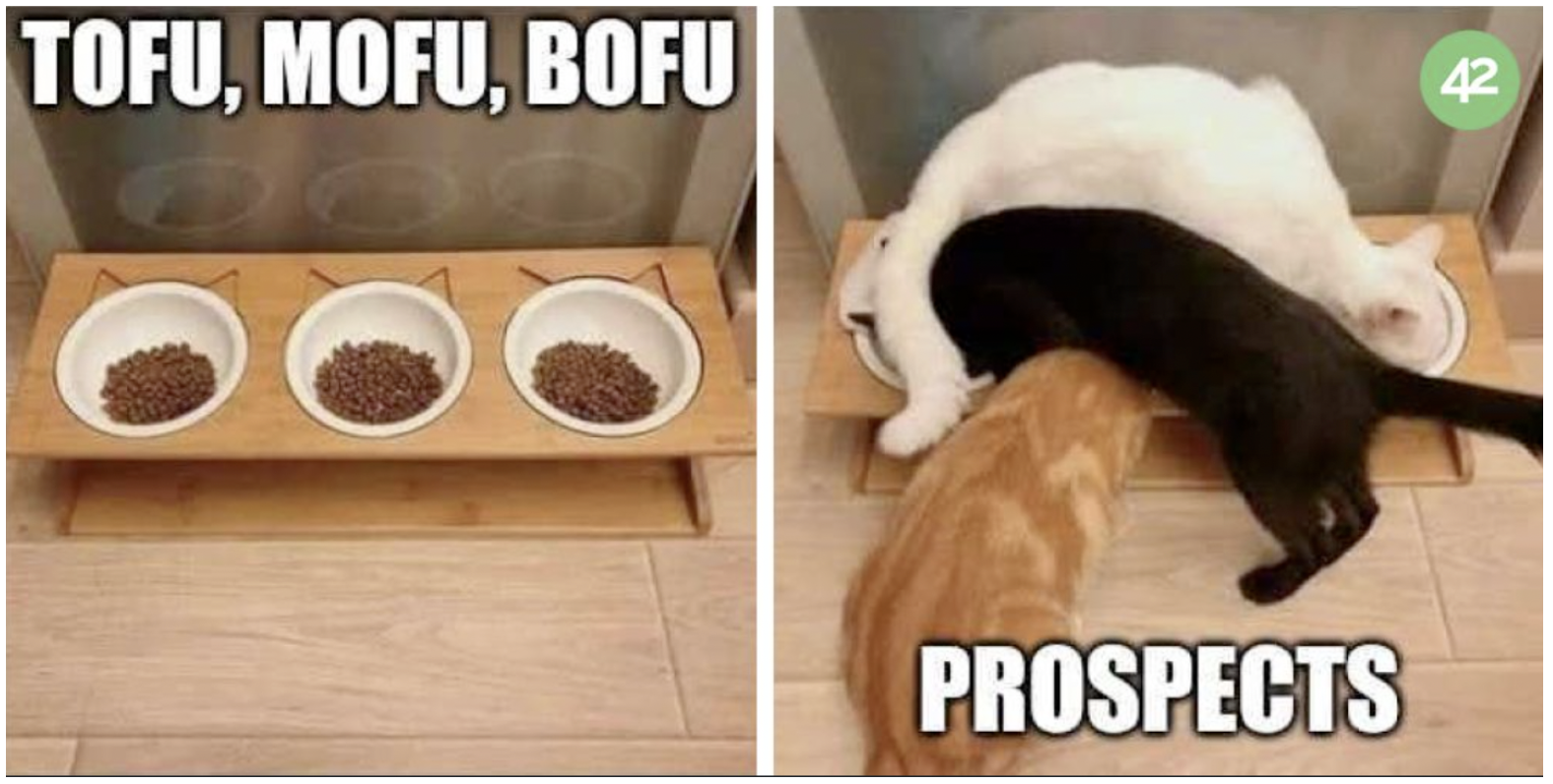
Now that you know the type of campaign you want to set up, you must keep in mind the variety of audiences you can find on LinkedIn.
There are several types of audiences on LinkedIn. There are native audiences, remarketing audiences (website visitors, ad engaged, lead form opened, lookalike audiences), 1st party custom audiences (contact list, company list - check out how you can use Dreamdata to build your custom audience), and 3rd party audiences (Liveramp, Bombora, etc.)
According to your objective and the type of campaign you want to set up, choose the right audience type.
After you have decided the type of campaign you want and the audience you want to reach, it is crucial to set up proper tracking. Otherwise, there is no way to understand if your marketing ad experiments yield any positive results. Add LinkedIn's insight tag and use conversion tracking using page-load with TYP page or an event-specific pixel with the submit button.
Generating leads & pipeline is vital for any organization, so be sure to integrate everything with a CRM, have a permanent and disciplined email follow-up plan, and retargeting. In follow-ups on email or via sales, customize it to the appropriate engagement that happened on ads. You wouldn't want to cold call for a demo when someone downloaded content, but asking for feedback on the downloaded content if it helped + a soft demo CTA wouldn't hurt.
Also ensure the content engaged on ad + linkedIn profile url fields gets passed on CRM. This is valuable intel for sales
LinkedIn Best Practices
We have compiled a list of best practices that you can use to accomplish your marketing goals. These are practices that have worked for us, yet, we encourage you to experiment and discover whatever works for you and your team.
1. Run brand awareness ads
- A mix of video views, impressions, and website visits.
- Why? - Frequency. These are cheap $$ touchpoints with the audience you target. Repetition + emotion = long term memory
- Tip: <30 sec videos perform better
- Leverage Single Image Engagement & Ads engagement to remarket
2. Run native lead gen forms for content & demo.
- Since LinkedIn has good targeting, there is no point in sending users to a landing page for downloading content.
- Hack: Add job title in case study heading. Ex: Guide to knowledge management vs. CEO's guide to knowledge management. Create relevant content and increase downloads.
3. Some sweet-spot numbers to bear in mind
- Demo ads - budget at least $200/day, 50000-200000 audience size, at least four ad variants seem to be a sweet spot for LI algorithm**
4. Rotate ads evenly vs. Optimize for performance
- If you want to A/B test, rotate ads evenly (option available on ad level) and pass on the metrics to your designer & copywriter as feedback on what worked.
5. While retargeting, intertwine TOFU, MOFU, BOFU
- Do not sequence. This way, anyone who engages with any of your buyer journey ads will be shown the other ads.
- People do not consume content linearly as per the buyer's journey.
6. Getting Attention on Ad
- People don't want ads and are mute to them. Customer research -> copy -> design helps create the magic to get attention. Read about absolute and sensory thresholds.
- Noob tip: Use Line breaks and emoticons on copy , Use red for attention, Capitalize on contrast - colours
7. Sell on Intro text, Sell on image text, Sell on the headline, Sell on the description
- Each of these, when read independently, should still give context as the user skims through an ad and might not read everything holistically.
- 8. Use custom audiences
- Upload target account lists, 1st party contact list, 3rd party lists and intent lists. Lists based on technographic data work great as well. We typically see higher conversions on custom audiences. Also, be sure to use OR conditions to add them into your primary campaign targeting if you are running on a tight budget.
- 9. Set conversion tracking even for lead-gen campaigns
- Track leads as well as conversions for lead-gen campaigns. CPL lowers further.
- 10. Some consumer behavior basics
- The ad gets users' attention only when it makes them cross a sensory threshold.
- Repetition and emotion push information from short-term memory to long-term memory. Customer research is key to evoking emotion.
- Generally, you need 6 to 8 touchpoints before a user takes action.
11. Creative:- Creative: Use bold colors to stand out against the blue white app.
- Creative with people stands out more than generic but Illustrations also work well
- Use 1200 X 1200 to maximize the real estate on mobile & get 75% higher CTRs
Now that you know how to set up a campaign fully, it is also essential to check your results to see what is working. We have created a daily checklist we believe you will also find invaluable.
Daily checklist
When it comes to Ads it is crucial to always be measuring. For this reason, we created a daily checklist that helps us keep track of everything. Check the metrics below compared to the previous day and the previous seven days to ensure your LinkedIn campaigns are working. Also, be sure to export all relevant data to be used for client and internal reporting.
- Are campaigns getting clicks / impressions? Try increasing budget/try manual bidding
- Are there any new leads?
- If you don't have a CRM/automation, hand over the leads to sales teams or add them to your email sequences.
- What is the daily spend?
- What is the average cost / lead
- What is the average frequency over the last 7 - 14 days?
- Have ads been shown too many times to the same audience? If frequency is > 3 - draw up a new creative & copy
- If performance is going down (i.e. Cost per Lead / Acquisition is increasing) or CTR is below 0.6%
- Try new audiences (check impressions / frequency) relative to audience size
- Try new creatives / ad copy / offer
- How much money do you have left? Is your budget enough?
- Can you pace the spending until the end of the month?
- If you can't pace - pause low performing / high cost ads
- Can you pace the spending until the end of the month?
Also, watch out for:
- LinkedIn Insight Tag not firing
- Ad fatigue
- Audience Saturation
- High CPC
- High CPL
Hidden Gems for your LinkedIn campaigns
There are many ways to optimize LinkedIn campaigns. However, one of the most useful ones we have found is to go to each of your campaigns in your campaign manager, click on the chart, select demographics, and exclude unrelated audiences to your offer.
Doing so will allow you to spend every dollar better.
After running campaigns for a few weeks, you can optimize the budget based on the amount spent, just like it is shown in the table below.
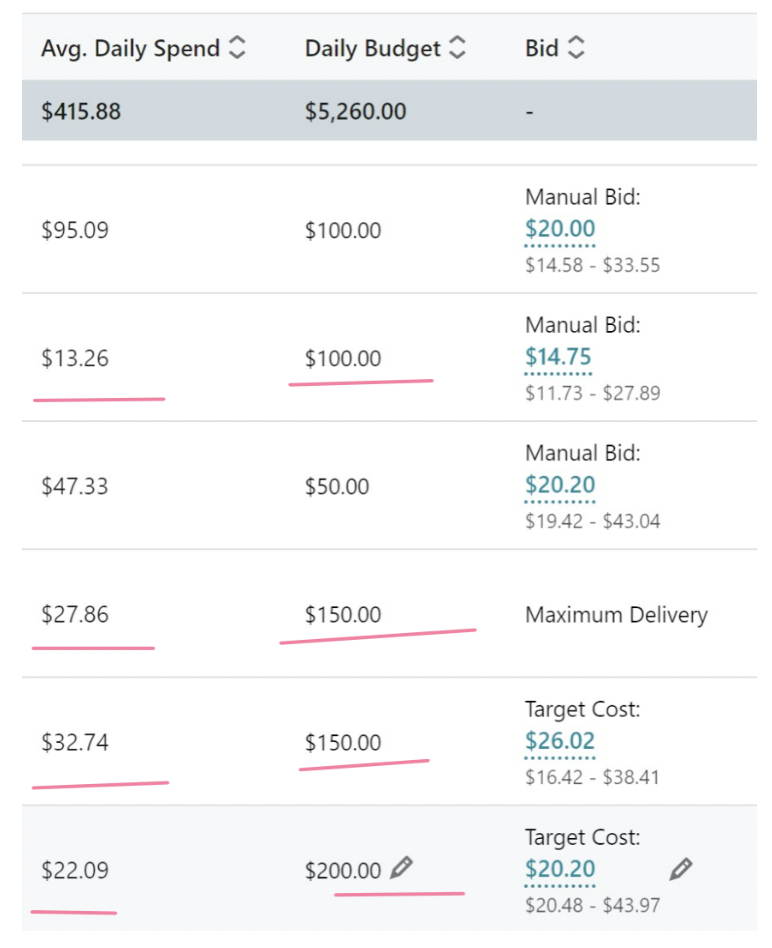
Note: Be sure you select the correct time range of the campaign so that you get the correct average daily spend
Cost Cap: LinkedIn Recently rolled out Target Cost for campaigns - where you can specify how much a conversion is worth & LinkedIn will try to keep the cost within those parameters. Keep in mind that:
- If your Cost is too low in the auction your ads won’t deliver.
- If your daily spend is not at least 2X the target cost you will limit delivery.
For example, my target cost for a demo is $500 but my daily budget is $200 - the ads won’t be able to deliver demos against your target cost because your bid is too low. This is similar to TCPA or Cost Cap on Google Ads & Facebook Ads
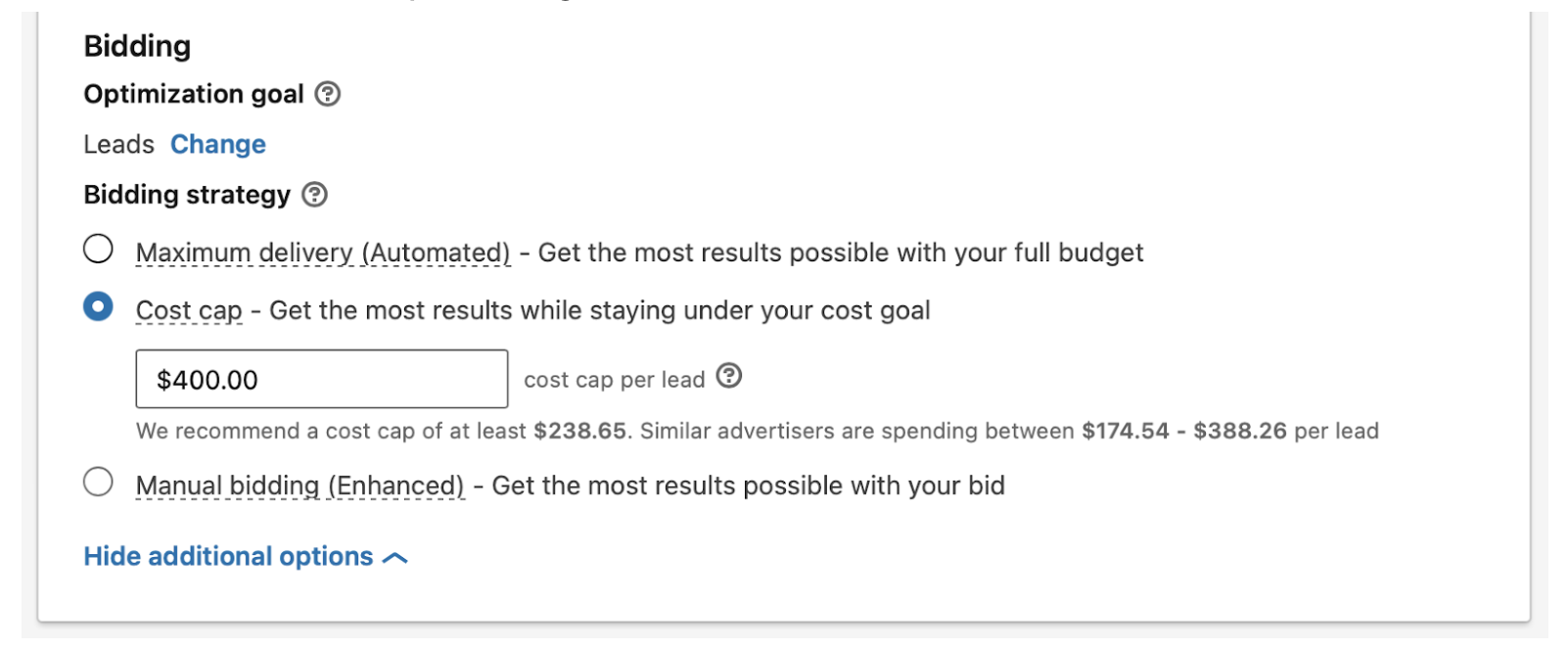
Manual Bidding:
LinkedIn will default to auto bidding to maximize spend vs results. However, if you’re just starting a campaign & want to maximize your spend you can set manual bids. Your manual bids can be at the mid - top end of a given range but lower then your daily budgets. For example, if my manual bid is 30 & my daily spend is 30 - I will likely only end up with a single click a day - not enough impressions & clicks to get meaningful results.
ABM opportunities
When it comes to LinkedIn there are 2 interesting opportunities for ABM or Account Based marketing.
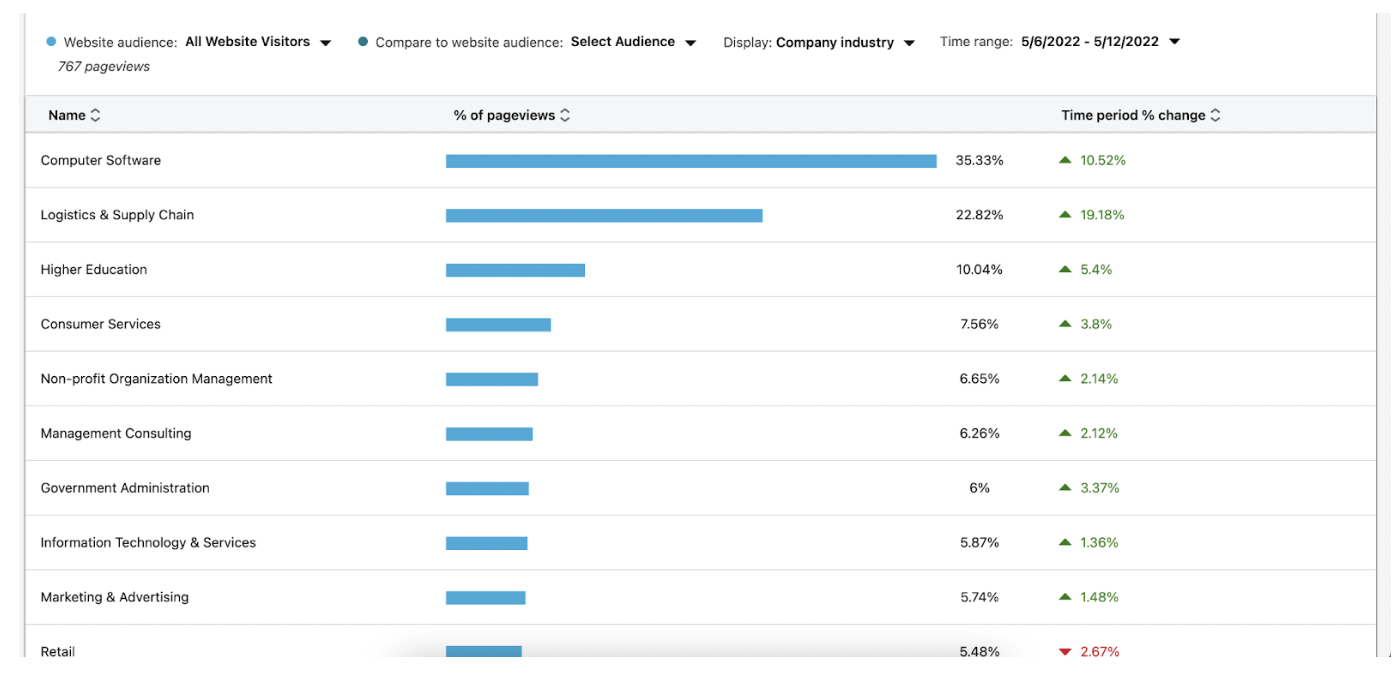
- LinkedIn’s Insights Pixel is extremely powerful in resolving anonymous web visitors to LinkedIn Demographic and company / industry information. In other words, simply by having the LinkedIn pixel installed, you will be able to access insights regarding demographics, job titles, company, industry, etc.
- Targeting specific accounts & contacts on LinkedIn with Custom Audiences is quite useful for marketers. The core difference between LinkedIn and a Facebook custom audience are the accounts. LinkedIn is a company + personal social network, which means you can target companies and contacts (who work at specific companies). Facebook or Adwords, on the other hand, are networks where your targeting is only contact-based. With custom LinkedIn account audiences you can create hyper customized ads and experiences for tier one accounts and provide specific messaging for each account.
- Keep in mind that for ABM opportunities LinkedIn ads can be run using: contact list upload, account list upload and retargeting ads based on website pages.
- For contact list upload - contact name and contact email address are necessary.
- For account list upload - Account name and Account website are necessary.
- Retargeting ads - personalized retargeting ads could be run on LinkedIn based on website urls users visited.
LinkedIn Ads Reporting
Now that you have created, optimized, and run your campaigns, it is equally essential to generate a report that informs the team on how the budget is performing. Although there are no absolute answers for reporting, we think that a piece of weekly information is essential (we are talking about massive budgets) to track everything and ensure it is performing as it should.
We set up our reports on Databox because it simplifies our work. However, we are tool agnostic. In reality, what matters is that you provide your client (internet and/or external) with:
- Spend.
- Conversions.
- Cost per action/acquisition (or whatever the key metric is).
- Pacing.
- Optimization recommendations.
- # of actions (demo/ lead/ signup) within the reporting period.
- Frequency
- Bid vs Spend (Daily) - are you maximizing your daily spend?
Be sure also to ask the appropriate stakeholder the following:
- To check in with sales to understand if converting leads are being closed.
- What % is added to the pipeline?
- What % converts into customers?
- What is a customer worth so you can work backwards and understand what a reasonable CPA is?
And then iterate.
LinkedIn Attribution
One of the most important skills any marketer should develop is the ability to create attribution models. LinkedIn is not an exception. Doing so properly will allow you to understand what is working and what is not.
When setting up your conversions, you can select how each ad interaction is credited for a conversion across multiple campaigns. The attribution model can be set to each campaign or a single campaign.
You can set campaigns attribution as:
- Each campaign: In this model, basically every campaign that had any interaction with the conversion will get credited with a conversion. This is great to understand the touchpoints and how they drive conversions across multiple campaigns - this is more of a multi-touch model
- Last campaign: In this scenario, only the last campaign will get credited with a conversion. This is the Last Touch Model.
Be sure to choose the one that makes more sense to you and that connects with the overall growth goals of the organization. Keep in mind that with ATT the iOS level data may not exactly reflect the results.
B2B attribution tools for a more holistic view
Bear in mind the limitations of LinkedIn’s single-source attribution.
For B2Bs, an account-based multi-touch attribution tool like Dreamdata, which tracks the end-to-end B2B customer journey, offers much greater accuracy in measuring performance against revenue and pipeline generated.

Playing long term + playing in tandem with sales.
Perhaps one of the most common scenarios in B2B SaaS companies is the obsession with only creating BOFU ads to speed up sales cycles. However, this can backfire, given that your potential market - only 10% is in-market at any given time while 80-90% are ‘out of market’ (i.e. not actively looking for a solution)

This means that you and your competitors are trying to get the attention of 10% of the market while ignoring the 90% (like fish in a barrel).
There’s something to be said for content & gated content & framing it as first party intent. We’ve seen success with closing business for enterprise customers using strategic relevant gated content.
Nurturing leads beyond that 10% that are ready to buy right away is crucial because it allows you to position your brand among potential buyers. Also, it allows your sales and marketing teams to collaborate and be curious about users. They will ask questions such as “how do they solve the problem we solve today? Why would they choose us over other products? What triggers purchase? etc.” And, by operationalizing curiosity and developing a true interest in solving the problems potential customers have you have better chances to create demand, capture value, and ultimately, close more than the 10% that are purchase-ready.
Parting thoughts
In this spree, we miss out some of the fundamentals of B2B marketing. Influencers (no, not the TikTok/Instagram influencers) but the ones that can positively influence your SaaS product. Of course, these champions, believe it or not, play a crucial role in pushing products and services across organizations, and the best of all is that given they are not targeted as often, they might be your secret weapon.
Don't you think a young associate can pass off a great product for a problem an organization faces during a team meeting?
Help these champions shine; it might be what you are missing from your ad campaigns.
B2B Ads have become so standardized that creativity became a needle in a haystack. We see the same old content downloads, thes same gift cards and CTA’s everywhere. This leads to apathy, being constantly targeted with Ads that are basically the same with different brand names and colour tones.
The good news is, your B2B SaaS can play by different rules. Running thoughtful and deep customer research activities and adding creativity to the mix you can stand out from the pacl and break through Ad clutter. Understand what drives value for your business & how your customers buy & align your LinkedIn Ads strategy to that.
.png)



.png)

